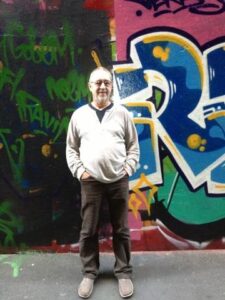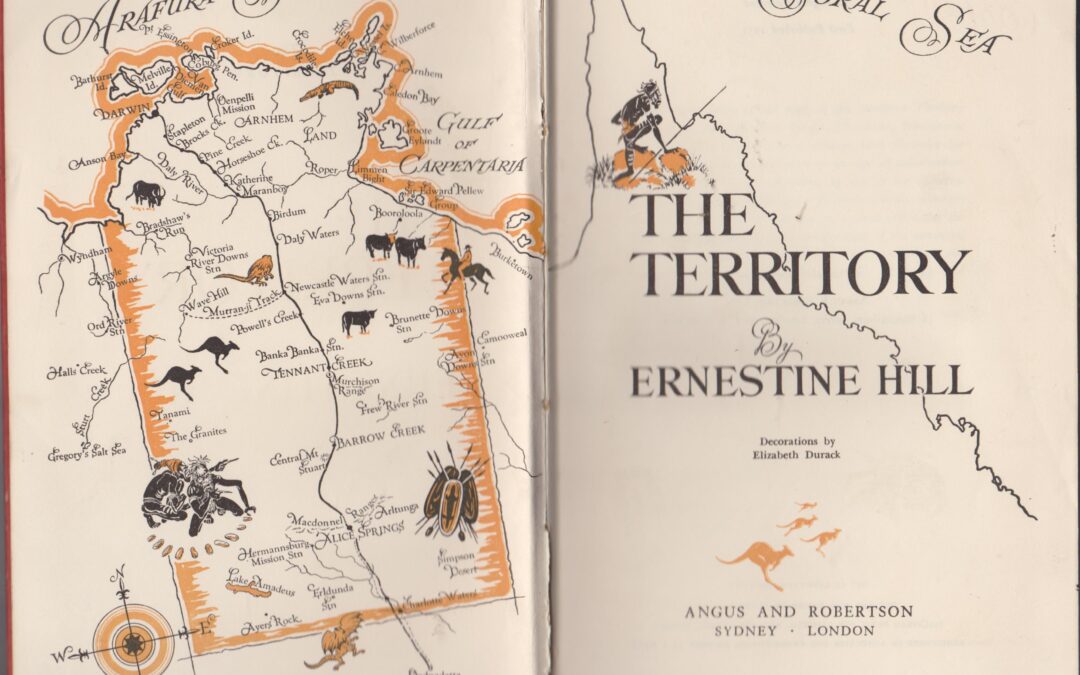by Bill Holloway
 The Australian Independent Woman takes many forms. Quite a number, like Catherine Helen Spence, Vida Goldstein and Miles Franklin were resolutely single, feminist activists; probably only Caroline Chisholm had a husband willing to play support; others, notably Rosa Praed, Louisa Lawson and Daisy Bates abandoned inconvenient husbands to pursue their dreams. Ernestine Hill took a newspaper magnate as her lover, bore him a son, and went on her way, travelling the Outback, a single mother, a famous writer.
The Australian Independent Woman takes many forms. Quite a number, like Catherine Helen Spence, Vida Goldstein and Miles Franklin were resolutely single, feminist activists; probably only Caroline Chisholm had a husband willing to play support; others, notably Rosa Praed, Louisa Lawson and Daisy Bates abandoned inconvenient husbands to pursue their dreams. Ernestine Hill took a newspaper magnate as her lover, bore him a son, and went on her way, travelling the Outback, a single mother, a famous writer.
I set this up a few weeks ago, then when the day came, Weds 11 Sept, I was away working, and I’m afraid scheduling a post (here or on my own blog) didn’t make it anywhere near the front of my mind.
Ernestine Hill (1899-1972) was a journalist, a documenter of life in outback Australia, an author. But Hill was also Catholic, resolutely single, and a mother. Born Mary Ernestine Hemmings, she adopted (Mrs) Hill as a sop to suburban sensibilities.
Ernestine was born and brought up firstly in north Queensland and then, on the death of her father when she was 10, in Brisbane. She won a scholarship to All Hallows (Catholic girls) School where she began to write, and had poems and essays published in the Catholic Advocate and, in 1916, a book entitled Peter Pan Land and Other Poems . From All Hallows She went on to Stott & Hoare’s Business College to learn typing and shorthand, and then, as top of the class, to the Queensland Public Service. Boring! Within a year she and her cousin Coy Foster-Lynam were on their way to Sydney to join the staff of Smith’s Weekly, a new satirical newspaper being founded by Claude McKay and Robert Clyde Packer, Coy as a junior journalist and Ernestine as secretary to Literary Editor, JF Archibald who in 1880 had co-founded and then edited The Bulletin through all its glory years with writers like Banjo Paterson and Henry Lawson.
On the death of Archibald (aged 63) after only 5 months, Ernestine was promoted by Packer to sub-editor. Although he was 20 years her senior, Ernestine later claimed that Packer, who was married with 2 children, was the love of her life. In any case within a few years she was pregnant, and in Oct. 1924 a son, Robert, was born in Melbourne. Ernestine took up a job, as Editor of the women’s pages, at The Examiner in Launceston, where she was joined by her mother and, intermittently by her mother’s sister Kitty, and with her son they formed her only family for the rest of her life.
In Tasmania, she took lessons from a professional photographer and bought herself “a little foldable Zeiss Ica” camera. She apparently became a fine photographer (the State Library of SA, have a collection titled ‘Along the Eyre Highway with Ernestine Hill‘ dated 1953)
By 1929 the Great Depression had begun but Hill was feeling restless. Packer, now General Manger of Associated Newspapers, found her a job, and more importantly, a monthly retainer, with the Sydney Sun, as a feature writer with a brief to file copy from the remotest corners of central Australia. With Aunt Kitty and Robert, she moved first to Perth and then to Carnarvon, then, leaving them behind, by steamer to Shark Bay where she was stuck for a month, then on to Cossack (near present-day Karratha) before gathering up her family again in time for Christmas in Broome. “She stayed there for most of 1930, collecting enough stories [about pearl diving mostly] to keep her editors happy for a while.” Then in Feb. 1931 she flew to Derby, hitched a ride in the mail truck to Hall’s Creek and eventually, on to Wyndham where she met, and travelled onwards into the Northern Territory with, Michael Durack, father of Mary and Elizabeth with whom she was to become, sort of, life-long friends.
If these travels sound familiar it is because they are the basis of Hill’s famous book of Australiana, The Great Australian Loneliness (1937), in the Foreword of which Hill writes:
It was in July, 1930, that I first set out, a wandering ‘copy-boy’ with swag and typewriter, to find what lay beyond the railway lines. Across the painted deserts and the pearling seas, by aeroplane and camel and coastal-ship, by truck and lugger and packhorse team and private yacht, the trail has led me on across five years and 50,000 miles, a trail of infinite surprises.
(I’ve driven Perth-NT-Cairns-Pt Augusta-Perth a couple of times and it’s 12,000 km the round trip, so “50,000 miles” – 80,000 km – might be an exaggeration). I have written previously that Ernestine Hill was a single mum but that her son was never mentioned in her writing and was almost certainly not with her. In fact, Robert was mostly with his great aunt or grandmother in Broome, and later in Perth, while Hill was travelling. Though it is interesting to glimpse the breaks in her travels, not mentioned in the book, where she flies home to spend time with them.
Robert who, let me say it, ends up a bit of a mummy’s boy, doesn’t amount to much. He studies art and during the war (WWII), Hill, who had been appointed to the Board of the Australian Broadcasting Commission, attempted to use her acquaintanceship with the PM, Curtin, to have him kept out of the army. When appeals failed they hid on a cattle station in the far north of SA. The army eventually caught up with Robert, but after 6 months he was invalided out on psychological grounds. Meanwhile, Ernestine resigned from the ABC citing stress.
Hill, while moving restlessly from city to city around the country, made some interesting literary friends. During the travels which led to The Great Australian Loneliness she met Daisy Bates at Ooldea, and subsequently returned to organise Daisy’s papers, which she, Bates, was loath to let anyone else see – providing linking chapters which were not used – which eventually appear as The Passing of the Aborigines (1938). Hill later wrote a biography of Daisy Bates, Kabbarli (1973) which did not appear until after her (Hill’s) death. She was also friends with Mary Durack, with whom Robert was for a while apparently rather too friendly, with artist, Elizabeth Durack (who did the illustrations below) and with poet, Henrietta Drake-Brockman.
After the war Robert and Ernestine purchased an ex-army 4WD in which they travelled from Mt Isa through the NT and down through WA to Perth. In 1947 Ernestine and Drake-Brockman then did a road trip across the Nullarbor, stopping in Coolgardie on the way to catch up with Katherine Susannah Prichard. The photographs in the State Library of SA exhibition appear to be of that trip.
Hill lived on what she earned from her writing. Marianne van Velzen in her partly fictionalized biography. Call of the Outback (2016) mentions a monthly payment which ceased on the death of Packer in 1934, if so that was the only acknowledgement of Robert’s paternity, which Robert later, fruitlessly, attempted to assert. She was a popular author – at a time when Australians read endless Australiana from her, Ion Idriess and Frank Clune – most particularly of the historical novel My Love Must Wait (1941), a fictionalised account of the voyages of Matthew Flinders.
Hill’s other, non-fiction works were –
Water into Gold (1937)
Australia: Land of Contrasts (1943)
Flying Doctor Calling (1947)
The Territory (1951)
A heavy smoker, she aged badly. Her mother and her aunt Kitty died in 1941 and ’43 respectively, and after the war her life and her writing both became more disorganised. In the sixties she promised her publisher another novel, ‘Johnny Wisecap: Albino Aborigine’, but (thankfully, probably) it was never finished.
Ernestine Hill died in Brisbane in 1972.
Earlier posts in this series:
The Independent Woman in Australian Literature
Bev Roberts ed., Miss D and Miss N: An Extraordinary Partnership (review)
Elizabeth Macarthur
Eleanor Dark, Timeless Land trilogy (review)
Caroline Chisholm, Married and Independent
Caroline Chisholm, Radical
Catherine Helen Spence, Woman’s Place in the Commonwealth
Catherine Helen Spence: An Autobiography (review)
Clare Wright, You daughters of freedom (review)
Janette M Bomford, That Dangerous and Persuasive Woman: Vida Goldstein (review)
Australian Suffragists
The New Woman in Australia
AWW Generation 1, 1788-1890 (list)
The Bulletin Years, 1890-1920
Miles Franklin, writer and activist
AWW Generation 2, 1890-1920 (list)
Ventured North by Train and Truck
Daisy Bates






